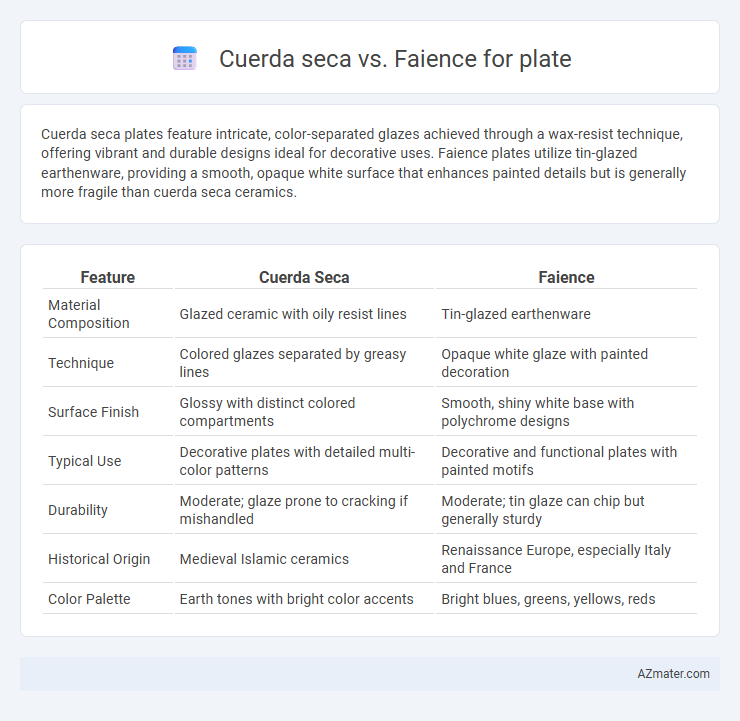Cuerda seca plates feature intricate, color-separated glazes achieved through a wax-resist technique, offering vibrant and durable designs ideal for decorative uses. Faience plates utilize tin-glazed earthenware, providing a smooth, opaque white surface that enhances painted details but is generally more fragile than cuerda seca ceramics.
Table of Comparison
| Feature | Cuerda Seca | Faience |
|---|---|---|
| Material Composition | Glazed ceramic with oily resist lines | Tin-glazed earthenware |
| Technique | Colored glazes separated by greasy lines | Opaque white glaze with painted decoration |
| Surface Finish | Glossy with distinct colored compartments | Smooth, shiny white base with polychrome designs |
| Typical Use | Decorative plates with detailed multi-color patterns | Decorative and functional plates with painted motifs |
| Durability | Moderate; glaze prone to cracking if mishandled | Moderate; tin glaze can chip but generally sturdy |
| Historical Origin | Medieval Islamic ceramics | Renaissance Europe, especially Italy and France |
| Color Palette | Earth tones with bright color accents | Bright blues, greens, yellows, reds |
Introduction to Decorative Plate Techniques
Cuerda seca and faience are distinct decorative plate techniques with unique visual and technical characteristics. Cuerda seca involves using greasy lines to separate colored glazes, creating intricate patterns that prevent colors from mixing during firing, mostly seen in Islamic ceramic art. Faience is a tin-glazed pottery method known for its bright, opaque white surface that serves as a canvas for vivid painted designs, popular in Mediterranean and European ceramic traditions.
Understanding Cuerda Seca: History and Process
Cuerda seca is a traditional ceramic glazing technique originating from Islamic pottery in the 9th century, characterized by its use of greasy lines to separate colors and prevent them from bleeding during firing. The process involves applying a greasy resist barrier to delineate intricate patterns, allowing multiple colored glazes to be fired simultaneously on a single plate without mixing. Compared to faience, which uses tin-opacified glaze to create opaque white surfaces for painting, cuerda seca offers more vivid color separation and sharper design definition on ceramic plates.
Faience: Origins and Artistic Evolution
Faience, originating in ancient Egypt around 4000 BCE, is a glazed non-clay ceramic material known for its vibrant turquoise-blue color and glossy finish. This technique evolved through the Mediterranean and Islamic cultures, where artisans refined its intricate glazing methods to produce detailed decorative plates with rich symbolism. Unlike cuerda seca, faience emphasizes a smooth, glass-like surface and vivid hues, making it particularly prized for artistic expression and historical significance in ceramic art.
Materials Used in Cuerda Seca Plates
Cuerda seca plates employ a ceramic technique using a clay body coated with colored glazes separated by grease lines that prevent color mixing during firing, preserving vivid patterns. The materials include silica-based clay, metal oxides for pigment, and a waxy greasy substance that creates the characteristic black outlines. This combination results in highly durable, heat-resistant ceramics with vibrant, intricate designs distinct from the opaque, tin-glazed faience plates.
Key Characteristics of Faience Plates
Faience plates are characterized by their tin-glazed earthenware, providing a bright white, opaque surface ideal for vibrant painted designs. They often feature intricate floral or geometric patterns with a glossy, smooth finish that resists moisture and wear. Unlike cuerda seca, faience relies on a single firing process with a lead-based glaze, resulting in durable, colorful, and highly decorative ceramic plates.
Visual Differences: Cuerda Seca vs Faience
Cuerda seca plates exhibit distinct bold, black outlines separating vibrant glazes, creating intricate, multi-colored patterns with a slightly raised texture. Faience plates feature smooth, glossy surfaces with more uniform, softly blended colors and detailed painted designs without prominent black lines. The visual contrast lies in cuerda seca's segmented, graphic look versus faience's seamless, delicate imagery.
Durability and Maintenance Comparison
Cuerda seca plates feature distinct, hand-painted designs separated by a greasy resist line that prevents color bleeding, offering moderate durability but requiring careful cleaning to avoid damaging the painted surface. Faience plates, made from tin-glazed earthenware, exhibit a hard, glossy finish that enhances resistance to wear, making them more durable and easier to maintain through simple washing without special precautions. While both techniques produce intricate and vibrant ceramics, faience plates tend to withstand daily use better and demand less delicate maintenance compared to cuerda seca plates.
Design Flexibility and Color Range
Cuerda seca technique offers greater design flexibility with intricate, segmented patterns allowing for detailed, multi-colored motifs without color bleeding. Faience, characterized by its tin-glazed ceramic surface, provides vibrant, glossy colors but is more limited to broader, simpler designs due to glazing constraints. The cuerda seca method supports a wider color range by using oily resist lines to separate pigments, enhancing complexity and durability in plate decoration.
Cultural Significance in Plate Decoration
Cuerda seca and faience techniques reflect distinct cultural heritages in plate decoration, with cuerda seca originating from Islamic art and known for its intricate, multicolored glaze patterns separated by greasy lines that prevent colors from blending. Faience, rooted in Mediterranean traditions, especially in Italian and French pottery, showcases tin-glazed ceramics characterized by bright, opaque colors and detailed hand-painted designs. Both methods demonstrate artistic innovation and regional identity, highlighting the cultural narratives embedded in decorative ceramics.
Choosing the Best Technique for Modern Plates
Cuerda seca and faience offer distinct aesthetic and functional qualities for modern plates, with cuerda seca providing vibrant, separated colors through a wax-resist technique that prevents glaze colors from bleeding, ideal for intricate, multicolor designs. Faience, a tin-glazed earthenware, delivers a smooth, opaque white surface that enhances painted motifs with a glossy finish and durability, favored for classic and contemporary styles requiring a refined look. Choosing between cuerda seca and faience depends on whether the priority is on vivid, separated patterns or a sleek, polished surface that supports detailed hand-painting.

Infographic: Cuerda seca vs Faience for Plate
 azmater.com
azmater.com